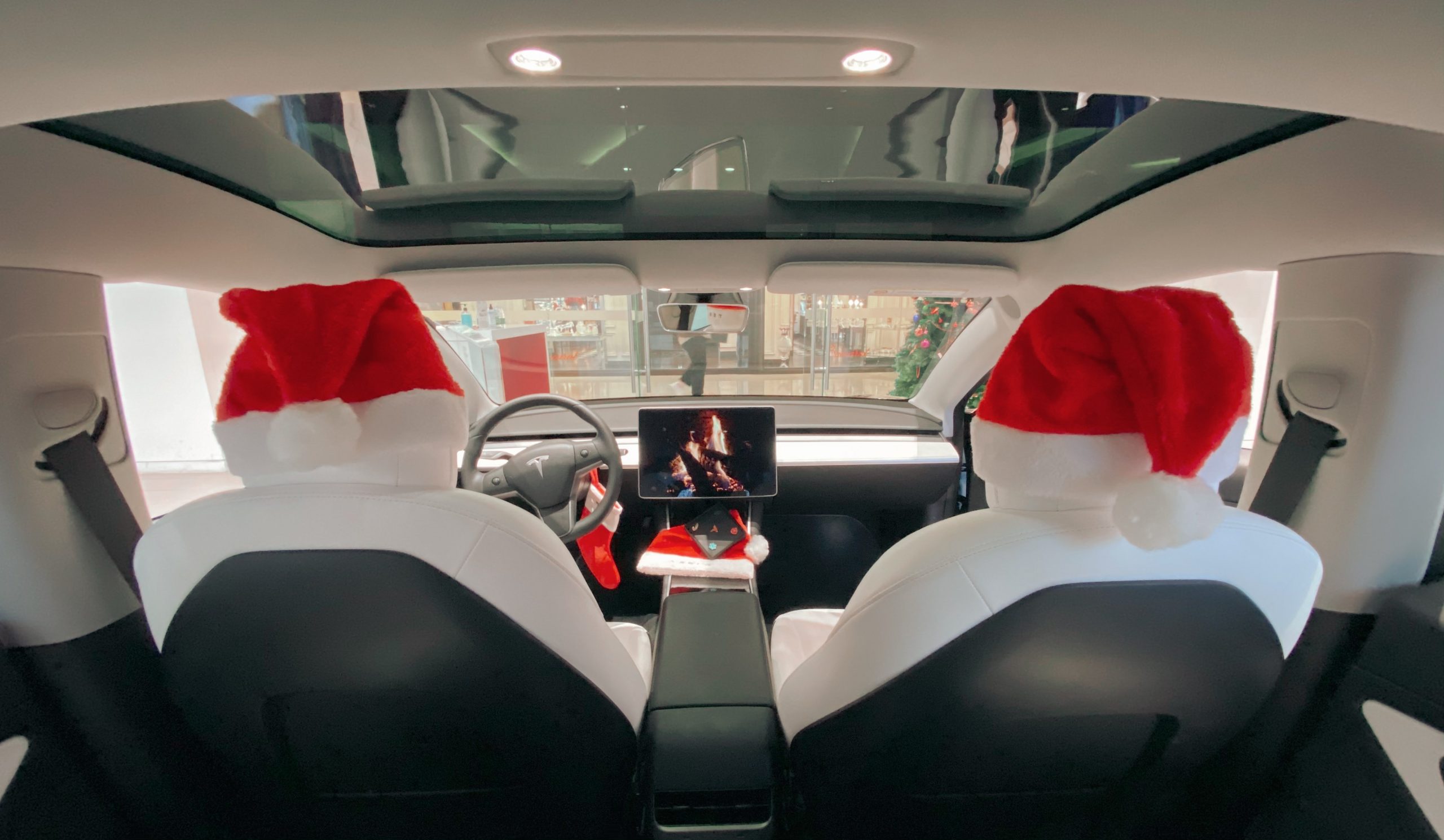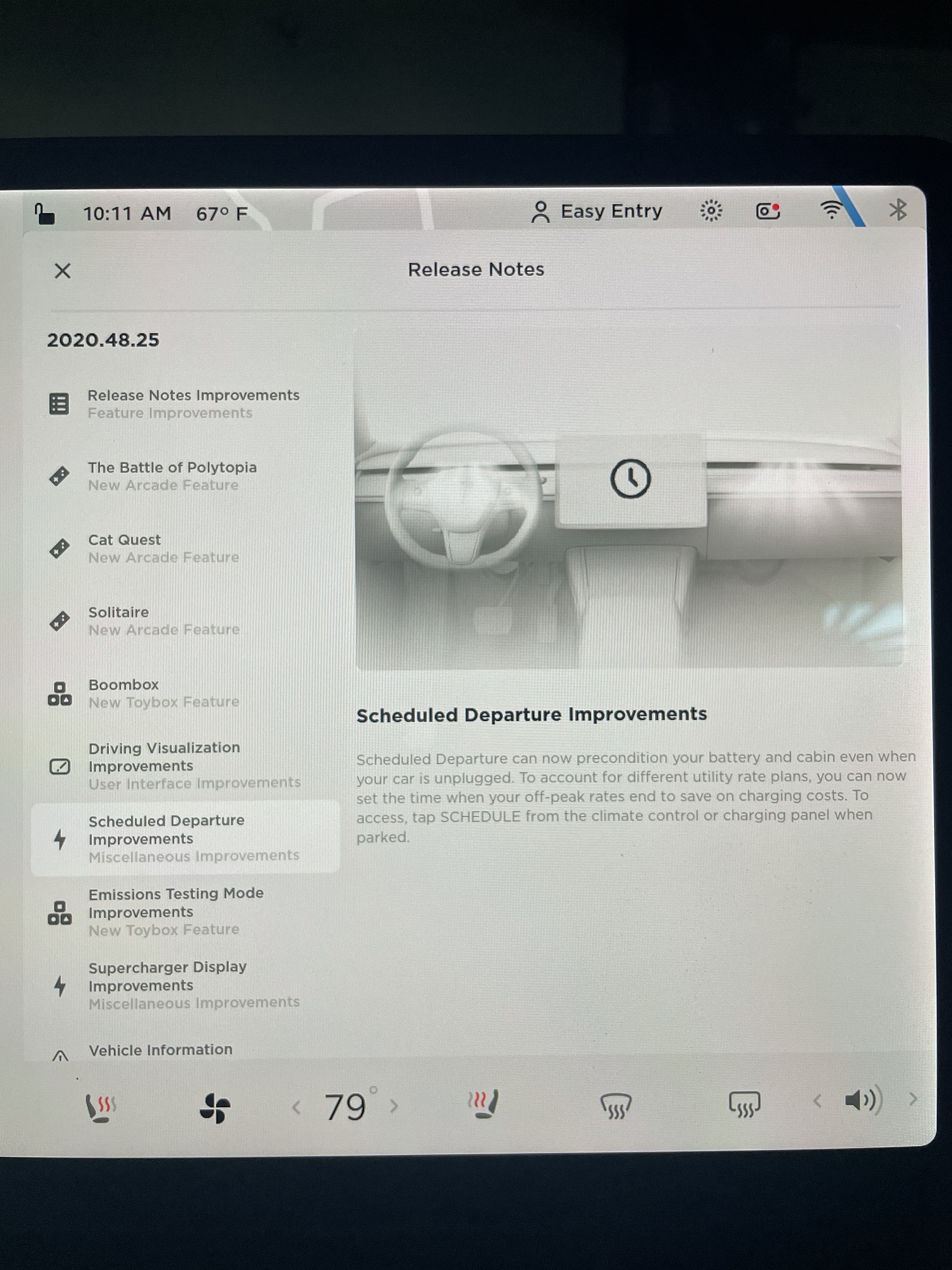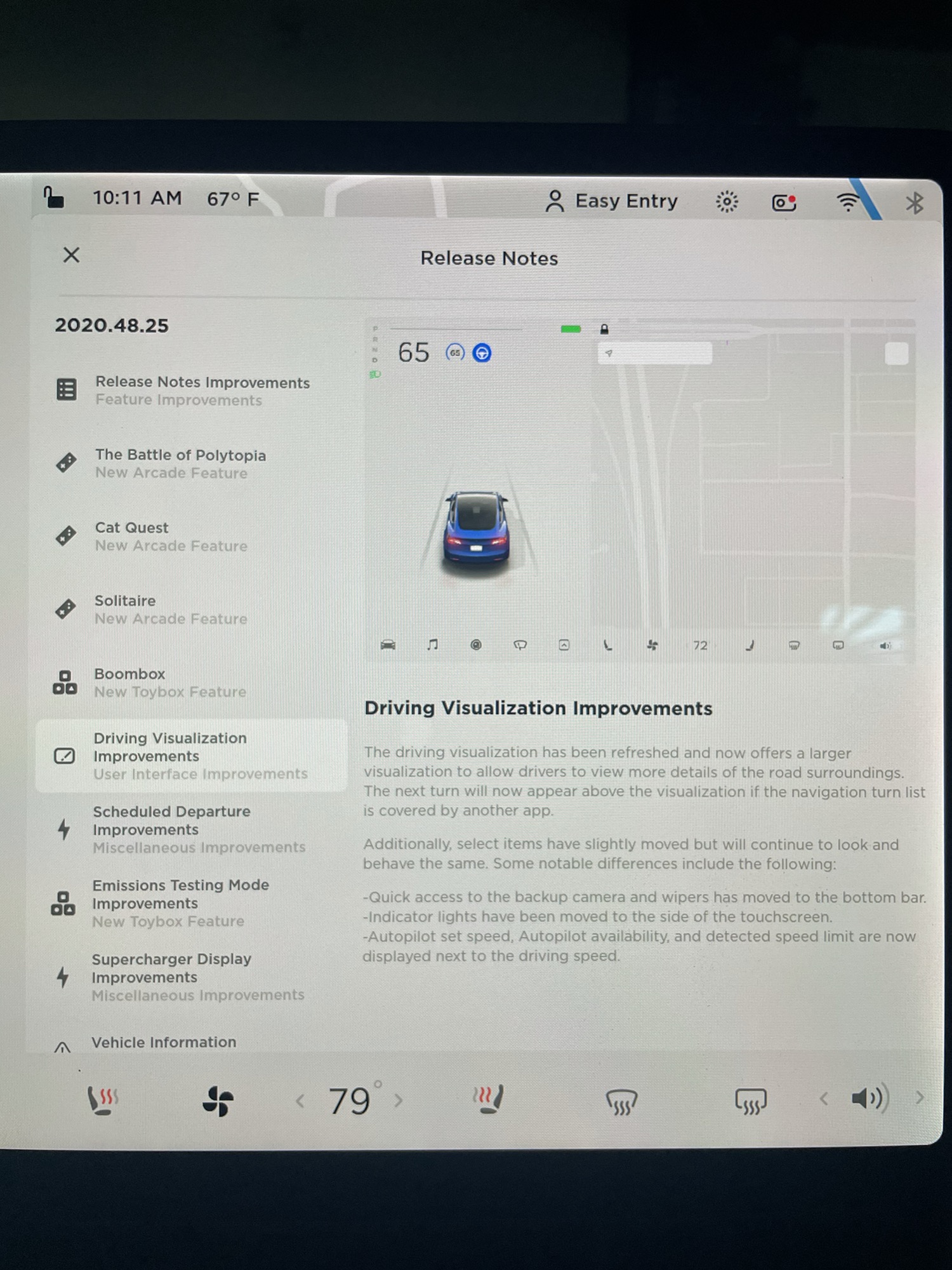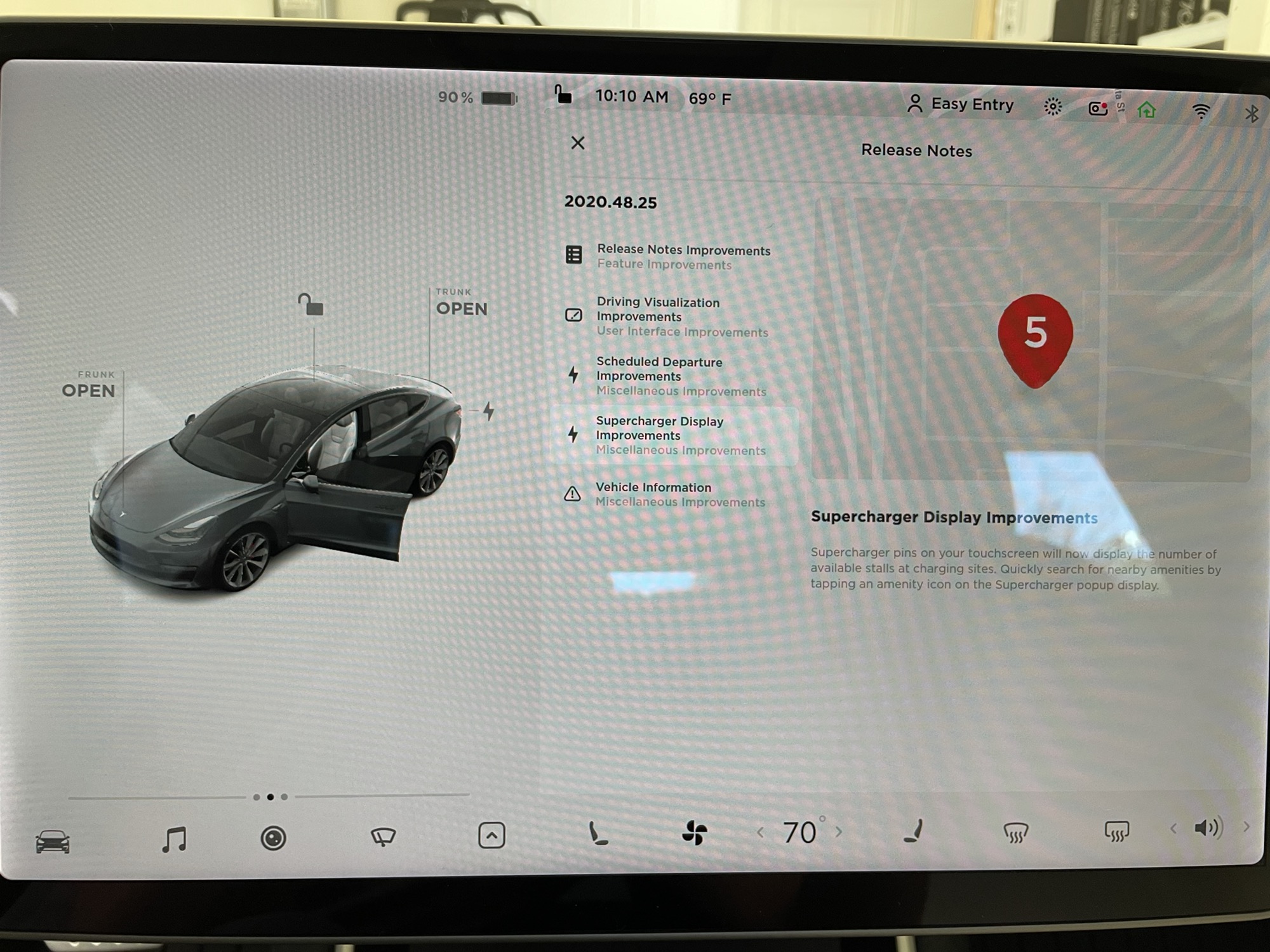

News
Tesla rolls out 2020 Holiday Update: New Driving Visualizations, Supercharger Display Improvements and more (Release Notes)
Tesla is beginning to roll out its highly anticipated over-the-air 2020 ‘Holiday Update’ that includes new driving visualizations for Full Self-Driving, new games, and an improved display for Supercharger and Vehicle Information, among others.
The following are some of the most notable aspects of Tesla’s 2020 holiday update as part of Firmware 2020.48.25.
Arguably, the Tesla community fan-favorite comes in the form of a new “Boombox” feature that enables the much-talked-about Snake Jazz and Goat easter eggs.
Vehicle Information
Tesla has removed the Tesla “T” from the top menu, which provides better use of the touchscreen display’s real estate. Display improvements can be seen throughout much of the 2020 Tesla Holiday Update.
“The Tesla ‘T’ has been removed from the top status bar. Tap Controls > Software for the same information.”
Release Notes Improvements
Release notes can be accessed under the controls menu. Each feature has been itemized into a tabular left menu that provides quick access to the description for previous and current features.
“Release notes now include improved browsing and access. To view current and previous release notes, tap controls > Software > Release Notes.”
Driving Visualization Improvements
Improved driving visualizations to support Full Self-Driving capabilities take center stage in this year’s highly-anticipated Tesla Holiday Software Update.
“The driving visualization has been refreshed and now offers a larger visualization to allow drivers to view more details of the road surroundings. The next turn will now appear above the visualization if the navigation turn list is covered by another app.
Additionally, select items have slightly moved but will continue to look and behave the same. Some notable differences include the following:
- Quick access to the backup camera and wipers has moved to the bottom bar.
- Indicator lights have been moved to the side of the touchscreen.
- Autopilot set speed, Autopilot availability, and detected speed limit are now displayed next to the driving speed.”
Scheduled Departure Improvements
A refreshed look for the “Scheduled Departure” feature, previously known as “Smart Preconditioning” and released in October 2019, puts more emphasis on a simple design for easier control of charging costs and interior comfort when ready to drive. Tesla notes that Scheduled Departure can operate even when the vehicle is unplugged.
The previous language of not being functional below a 20% battery state of charge is no longer visible.
“Schedule departure can now precondition your battery and cabin even when your car is unplugged. To account for different utility rate plans, you can now set the time when your off-peak rates end to save on charging costs. To access, tap SCHEDULE from the climate control or charging panel when parked.”

Supercharger Display Improvements
Real-time Supercharger occupancy information was rolled out nearly 4 years ago (see version 1.0), and since then Tesla has continued to make user experience improvements for drivers looking to quickly access information from their touchscreen for distraction-free driving. This includes the ability to see available charging stalls at-a-glance and without the need for unnecessary taps of the touchscreen.
“Supercharger pins on your touchscreen will now display the number of available stalls at charging sites. Quickly search for nearby amenities by tapping an amenity icon on the Supercharger popup display.”
Tesla has replaced the iconic Tesla Supercharger lightning bolt icon with a number that denotes the number of currently available chargers at the location.
Emissions Testing Mode Improvements
How can one improve upon Tesla’s famed “Emissions Testing Mode”, better known as “Fart Mode”? Fart at strangers.
“Emissions Testing Mode can be used outside the car. To setup, select your desired sound and place the cushion on the external speaker. When ready, play selected sound by pressing the left scroll wheel button or using the turn signal. To access, tap the Application Launcher > Toybox > Emissions Testing Mode.”

Boombox
Elon Musk has made good on his promise to give Tesla owners the ability to entertain crowds and passersby through honking-fart and goat sounds, plus more.
Customized horn & movement sounds (coconuts being one, of course) coming to Teslas soon— Elon Musk (@elonmusk) October 6, 2019
In addition to several new out-of-the-box sound clips that blast out of Tesla’s exterior speaker, the latest Boombox feature enables the upload of five custom sounds.
“Turn your car into a boombox and entertain a crowd with your media player when parked. You can also customize the sound your car makes when you press the horn, drive the car or when your car is moving with Summon. Select an option from the dropdown menu or insert your own USB device and save up to five custom sounds.”
Tesla Arcade: New Games
Tesla launched a series of new games for its Tesla Arcade collection, including The Battle of Polytopia, Cat Quest, Solitaire, and Boombox.
- The Battle of Polytopia
- Cat Quest
- Solitaire
Last month, Elon Musk teased the community when he tweeted about this year’s holiday software update. Musk hinted that 2020’s holiday update would be “lit.” He also mentioned that the highly-anticipated update would include features that customers wanted, and some that they didn’t even know they wanted.
Last year, Elon Musk and the Tesla team outdid themselves with the holiday software update. Tesla’s 2019 holiday update included a sneak preview of the company’s Full Self Driving suite, TRAX v0.1, and introduced new games to the arcade, such as Stardew Valley and Lost Backgammon.

News
Tesla starts showing how FSD will change lives in Europe
Local officials tested the system on narrow country roads and were impressed by FSD’s smooth, human-like driving, with some calling the service a game-changer for everyday life in areas that are far from urban centers.

Tesla has launched Europe’s first public shuttle service using Full Self-Driving (Supervised) in the rural Eifelkreis Bitburg-Prüm region of Germany, demonstrating how the technology can restore independence and mobility for people who struggle with limited transport options.
Local officials tested the system on narrow country roads and were impressed by FSD’s smooth, human-like driving, with some calling the service a game-changer for everyday life in areas that are far from urban centers.
Officials see real impact on rural residents
Arzfeld Mayor Johannes Kuhl and District Administrator Andreas Kruppert personally tested the Tesla shuttle service. This allowed them to see just how well FSD navigated winding lanes and rural roads confidently. Kruppert said, “Autonomous driving sounds like science fiction to many, but we simply see here that it works totally well in rural regions too.” Kuhl, for his part, also noted that FSD “feels like a very experienced driver.”
The pilot complements the area’s “Citizen Bus” program, which provides on-demand rides for elderly residents who can no longer drive themselves. Tesla Europe shared a video of a demonstration of the service, highlighting how FSD gives people their freedom back, even in places where public transport is not as prevalent.
What the Ministry for Economic Affairs and Transport says
Rhineland-Palatinate’s Minister Daniela Schmitt supported the project, praising the collaboration that made this “first of its kind in Europe” possible. As per the ministry, the rural rollout for the service shows FSD’s potential beyond major cities, and it delivers tangible benefits like grocery runs, doctor visits, and social connections for isolated residents.
“Reliable and flexible mobility is especially vital in rural areas. With the launch of a shuttle service using self-driving vehicles (FSD supervised) by Tesla in the Eifelkreis Bitburg-Prüm, an innovative pilot project is now getting underway that complements local community bus services. It is the first project of its kind in Europe.
“The result is a real gain for rural mobility: greater accessibility, more flexibility and tangible benefits for everyday life. A strong signal for innovation, cooperation and future-oriented mobility beyond urban centers,” the ministry wrote in a LinkedIn post.
News
Tesla China quietly posts Robotaxi-related job listing
Tesla China is currently seeking a Low Voltage Electrical Engineer to work on circuit board design for the company’s autonomous vehicles.

Tesla has posted a new job listing in Shanghai explicitly tied to its Robotaxi program, fueling speculation that the company is preparing to launch its dedicated autonomous ride-hailing service in China.
As noted in the listing, Tesla China is currently seeking a Low Voltage Electrical Engineer to work on circuit board design for the company’s autonomous vehicles.
Robotaxi-specific role
The listing, which was shared on social media platform X by industry watcher @tslaming, suggested that Tesla China is looking to fill the role urgently. The job listing itself specifically mentions that the person hired for the role will be working on the Low Voltage Hardware team, which would design the circuit boards that would serve as the nervous system of the Robotaxi.
Key tasks for the role, as indicated in the job listing, include collaboration with PCB layout, firmware, mechanical, program management, and validation teams, among other responsibilities. The role is based in Shanghai.
China Robotaxi launch
China represents a massive potential market for robotaxis, with its dense urban centers and supportive policies in select cities. Tesla has limited permission to roll out FSD in the country, though despite this, its vehicles have been hailed as among the best in the market when it comes to autonomous features. So far, at least, it appears that China supports Tesla’s FSD and Robotaxi rollout.
This was hinted at in November, when Tesla brought the Cybercab to the 8th China International Import Expo (CIIE) in Shanghai, marking the first time that the autonomous two-seater was brought to the Asia-Pacific region. The vehicle, despite not having a release date in China, received a significant amount of interest among the event’s attendees.
Elon Musk
Elon Musk and Tesla AI Director share insights after empty driver seat Robotaxi rides
The executives’ unoccupied tests hint at the rapid progress of Tesla’s unsupervised Robotaxi efforts.

Tesla CEO Elon Musk and AI Director Ashok Elluswamy celebrated Christmas Eve by sharing personal experiences with Robotaxi vehicles that had no safety monitor or occupant in the driver’s seat. Musk described the system’s “perfect driving” around Austin, while Elluswamy posted video from the back seat, calling it “an amazing experience.”
The executives’ unoccupied tests hint at the rapid progress of Tesla’s unsupervised Robotaxi efforts.
Elon and Ashok’s firsthand Robotaxi insights
Prior to Musk and the Tesla AI Director’s posts, sightings of unmanned Teslas navigating public roads were widely shared on social media. One such vehicle was spotted in Austin, Texas, which Elon Musk acknowleged by stating that “Testing is underway with no occupants in the car.”
Based on his Christmas Eve post, Musk seemed to have tested an unmanned Tesla himself. “A Tesla with no safety monitor in the car and me sitting in the passenger seat took me all around Austin on Sunday with perfect driving,” Musk wrote in his post.
Elluswamy responded with a 2-minute video showing himself in the rear of an unmanned Tesla. The video featured the vehicle’s empty front seats, as well as its smooth handling through real-world traffic. He captioned his video with the words, “It’s an amazing experience!”
Towards Unsupervised operations
During an xAI Hackathon earlier this month, Elon Musk mentioned that Tesla owed be removing Safety Monitors from its Robotaxis in Austin in just three weeks. “Unsupervised is pretty much solved at this point. So there will be Tesla Robotaxis operating in Austin with no one in them. Not even anyone in the passenger seat in about three weeks,” he said. Musk echoed similar estimates at the 2025 Annual Shareholder Meeting and the Q3 2025 earnings call.
Considering the insights that were posted Musk and Elluswamy, it does appear that Tesla is working hard towards operating its Robotaxis with no safety monitors. This is quite impressive considering that the service was launched just earlier this year.













